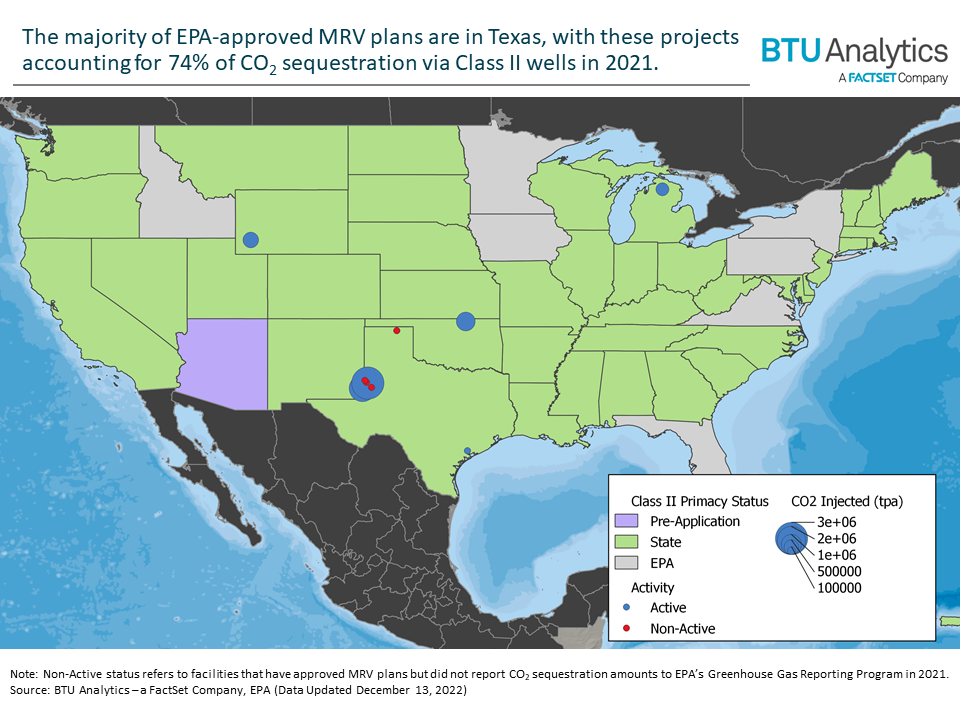The Inflation Reduction Act (IRA) offers several different pathways for claiming the 45Q tax credit for secure geologic storage, including geologic sequestration and utilization for Enhanced Oil Recovery (EOR). Last month, BTU Analytics focused on the Class VI well, which is one of two well types that can be used to inject CO2 for geologic storage and qualify for 45Q tax credits. In this Energy Market Insight, we shift our focus to the second well type, the Class II well, and discuss the various ways in which this well can store CO2 and be utilized to acquire 45Q tax credits.
Class II wells are used for three different purposes that all involve the injection of fluids associated with oil and natural gas production: brine and wastewater disposal, liquid hydrocarbon storage, and EOR. While most US states have primacy for Class II wells, which gives them the authority to control the permitting process for this well type, the EPA currently authorizes permits for Class II wells in eight states.
Class II wells that inject CO2 for disposal or EOR are eligible for 45Q tax credits if they can provide long-term sequestration of the CO2 post-injection. Any entity that is interested in claiming 45Q tax credits via a Class II well for disposal must submit a Monitoring, Reporting and Verification (MRV) plan to the EPA, and any entity wanting to claim credits via a Class II well for EOR must submit an MRV plan to the EPA or create a monitoring and containment assurance plan that meets the standards of the International Organization for Standardization (ISO). While the details of an ISO plan are private, MRV plans are published by the EPA and must provide important project details, such as where the CO2 is being injected, potential surface leakage pathways for the CO2, and how the facility will calculate the amount of CO2 injected. If the MRV plan is approved by the EPA, then the facility can begin counting sequestered CO2 towards 45Q tax credits. Recent MRV applications have been approved within several months of submission, allowing for a relatively quick turnaround for companies looking to capitalize on existing well infrastructure.

There are currently twelve EPA-approved MRV plans for Class II wells in the US, with the majority of these plans relating to EOR projects. As of 2021, EOR accounted for 89% of the nearly 39 million tonnes of CO2 that had been stored via Class II wells since 2015. Storage of CO2 through Class II EOR wells is also considerably larger than with Class VI wells. This large proportion of CO2 storage through EOR is due to the relatively high number of Class II injection wells that are involved in EOR operations. Combined, the 12 current MRV plans include seven Class II disposal wells and over 900 active or planned Class II EOR wells. There are also only two Class VI wells that have been permitted and approved for CO2 sequestration. Therefore, the sheer number of EOR CO2 injection wells results in higher sequestration rates for EOR than disposal projects or Class VI wells.

The IRA offers $60/t of CO2 stored via Class II wells during EOR operations. Operational EOR projects are an attractive option for acquiring 45Q credits since the CO2 infrastructure is already in place, they operate numerous Class II wells, and the MRV application turnround is relatively quick. EOR operations that claim 45Q tax credits may also be able to leverage their credits as proof of producing low-carbon oil and gas for consumers. Disposal projects are also ideal candidates for similar reasons. However, these projects may gain less from the 45Q tax credits than EOR projects, since they typically have fewer Class II wells and store smaller amounts of CO2 per year. Regardless, BTU Analytics expects to see a growing number of MRV applications for Class II wells and anticipates that Class II wells will continue to be the main method of geologic CO2 storage until many Class VI wells are permitted and approved for CO2 sequestration.
To see more analysis and insights from BTU Analytics about the Energy Transition, and to be the first to see new BTU products on the Energy Transition, email info@btuanalytics.com with the subject line “Energy Transition”.









